|
|
| Line 602: |
Line 602: |
| | {| width="50%" cellspacing="1" cellpadding="1" border="1" class="wikitable" | | {| width="50%" cellspacing="1" cellpadding="1" border="1" class="wikitable" |
| | |- | | |- |
| − | | | + | | [[Image:Custom_Reports_018.png]] |
| | |- | | |- |
| | | | | | |
| − | '''<span style="color: rgb(255, 0, 0);">A: </span>'''The separation label is "Activity". | + | '''<span style="color: rgb(255, 0, 0);">A: </span>'''The separation label is "Activity". |
| | | | |
| | |- | | |- |
| | | | | | |
| − | '''<span style="color: rgb(255, 0, 0);">B: </span>'''The "Activity" separations are sorted in asecnding order. | + | '''<span style="color: rgb(255, 0, 0);">B: </span>'''The "Activity" separations are sorted in asecnding order. |
| | | | |
| | |- | | |- |
| | | | | | |
| − | '''<span style="color: rgb(255, 0, 0);">E: </span>'''The separation is named "Occasion", but the label is not visible. | + | '''<span style="color: rgb(255, 0, 0);">E: </span>'''The separation is named "Occasion", but the label is not visible. |
| | | | |
| | |- | | |- |
| − | | | + | | [[Image:Custom_Reports_019.png]] |
| | |- | | |- |
| | | | | | |
| − | '''<span style="color: rgb(255, 0, 0);">C: </span>'''The option "Change a page" has been checked, there is therefore only one activity per page. The second activity can then be found on the second page. | + | '''<span style="color: rgb(255, 0, 0);">C: </span>'''The option "Change a page" has been checked, there is therefore only one activity per page. The second activity can then be found on the second page. |
| | | | |
| | |- | | |- |
| | | | | | |
| − | '''<span style="color: rgb(255, 0, 0);">D: </span>'''A separation per activity has been added and the "Invisible" box has been checked. This way, the name of the separation does not appear. | + | '''<span style="color: rgb(255, 0, 0);">D: </span>'''A separation per activity has been added and the "Invisible" box has been checked. This way, the name of the separation does not appear. |
| | | | |
| | + | |- |
| | + | | [[Image:Custom_Reports_020.png]] |
| | |- | | |- |
| | | | | | |
| − | |-
| + | '''<span style="color: rgb(255, 0, 0);">F: </span>'''Instead of adding two separations(one "Occasion" separation and one "Activity" separation), only one separation with two fields has been added (the separation label is "Per Occasion and Activity"), which allows the name of the occasion and the name of the activity to be on the same line and in each separation. If two separations had been added, the name of the occasion would have been indicated only once; which means right before the first activity, to view an example, see letters <span style="color: rgb(255, 0, 0);">'''A'''</span> and <span style="color: rgb(255, 0, 0);">'''E'''</span>. |
| − | | '''<span style="color: rgb(255, 0, 0);">F: </span>'''Instead of adding two separations
| + | |
| | |} | | |} |
| | | | |
Revision as of 10:00, 22 August 2011
Template:Header ProDon
Introduction
The custom reports tool allows you to create reports from a search conducted previously.
Firstly, it is important to know that:
- It is possible to create a custom report from all the management grids in which the report icon
 is active (blue).
is active (blue).
- A report is always attached to a precise management grid. For instance, if it is created in the "Transaction management", it doesn't appear in the "Client management".
- The fields available for the creation of a report are the same as the ones in the corresponding management grid (columns).
- It is possible to include summaries to the reports only from the "Client management" and "Analysis & History".
- Each management grid contains files (e.g. the client file in the "Client management" grid) and it is possible to generate an existing report from each of these files. However, it is not possible to create a new one.
Managing the Reports Available
First of all, go in the management proper to the type of report you want to create, modify or delete.
Click on the  button.
button.
|
This window opens.
|
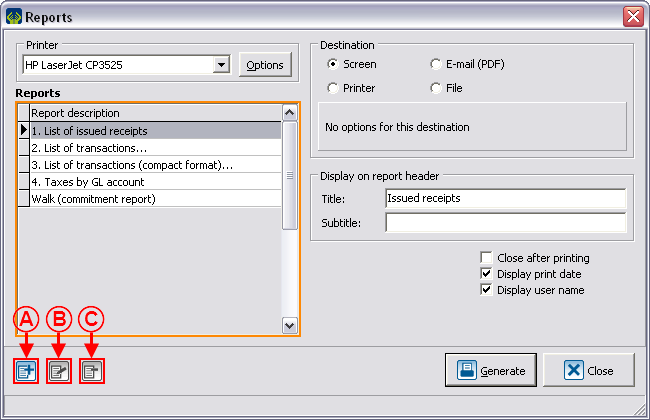
|
|
A: The  button allows you to create a new report. button allows you to create a new report.
|
B: The  button allows you to modify a report. button allows you to modify a report.
|
|
C: The  button allows you to delete a report. button allows you to delete a report.
|
NOTE: The reports provided by Logilys are not modifiable nor deletable.
|
Creation of a Custom Report
Go to the management proper to the type of report you want to create.
Conduct a search by criterion using the search bar, so that the management grid corresponds to what should be found on the report.
Once the management grid corresponds to what should be found on the report, click on the  button.
button.
To create a new report, click on the  button.
button.
|
This window opens.
|
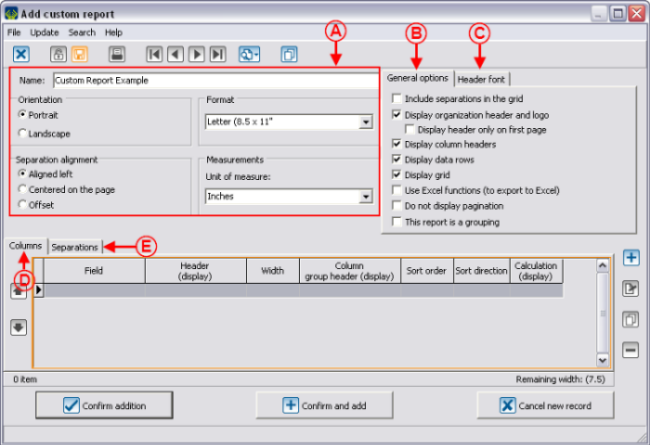
|
|
A: This section allows you to configure the visual options.
|
B: The "General options" tab allows you to configure the general option of the custom report.
|
|
C: The "Header font" tab allows you to choose the header font of the report.
|
D: The "Columns" tab allows you to add columns to the report.
|
|
E: The "Separations" tab allows you to add separations to the report.
|
|
Configuration of the Visual Options
|
For all the following examples concerning the visual configuration, refer to the "Examples of Visual Options" section.
|
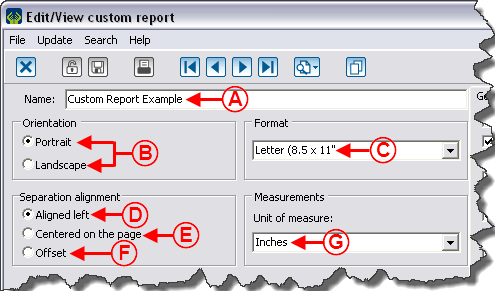
|
|
A: Allows you to name the custom report.
|
B: Allows you to decide whether the report will be generated in "Portrait" or "Landscape" orientation.
|
|
C: Allows you to choose on which paper format the report will be generated (e.g. 8,5 X 11", 8,5 X 14", etc.).
|
D: This option allows you to align the separations to the left. To view an example of left alignment, see letter B.
|
|
E: This option allows you to centre the separations alignment. To view an example of centred separation, see letter G.
|
F: This option allows you to offset the separations alignment. To view an example of offset separation, see letter I.
|
|
G: Allows you to choose the unit of measurement to be used for the width of the report columns.
|
|
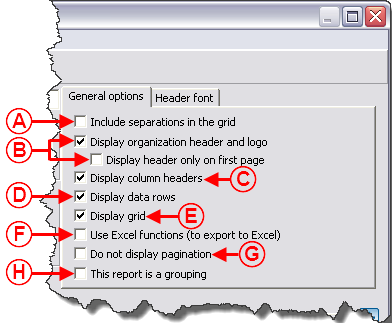
|
|
A: Allows you to include separations in the grid. To view an example of separation above the grid, see letter B. To view an example of separation in the grid, see letter G.
|
B: Displays the header and the logo of the organization on the first page only or on all the pages of the report. To view an example of header, see letter A.
|
|
C: Displays the header of the columns. To view an example of column header, see letter C.
|
D: Displays the data lines. To view an example of data lines, see letter D.
|
|
E: Displays the grid. To view an example of report with a grid, see letter E. To view an example of report without a grid, see letter J.
|
F: Uncheck this box if Excel sends an error message during the exportation.
|
|
G: If the box is checked, the pagination will be on the report. If the box is not checked, the pagination will not be displayed.
|
H: Activates the grouping option on the report. To view an example of report without the grouping option, see letter F. To view an example of report with the grouping function, see letter H. For more information concerning the grouping option, click here.
|
Examples of Visual Options
First Example
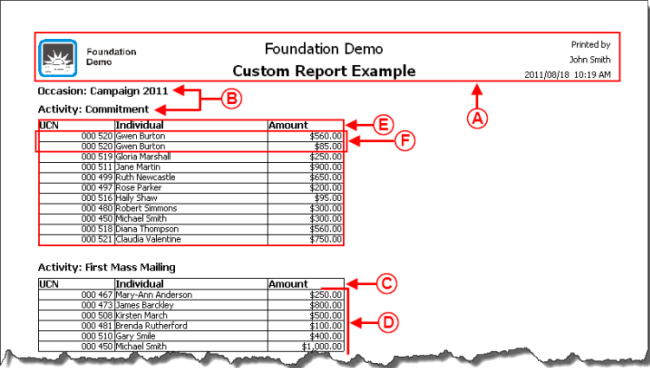
|
|
A: It is the header including the logo of the organization.
|
B: Example of report when the separations are aligned to the left and above the grid.
|
|
C: This line is a column header.
|
D: These lines are the data lines.
|
|
E: Example of report when the option "Display grid" is checked.
|
F: Example of report when the grouping option is not checked. If it had been checked, Mrs.Gwen Burton would have appeared only once and her two donations would be added. See the example in H for a grouped report. For more information concerning the grouping option, click here.
|
Second Example
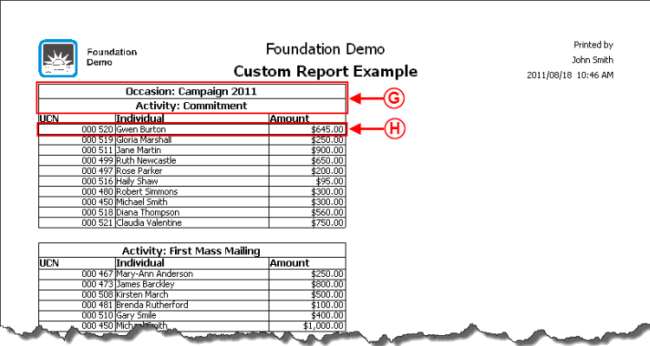
|
|
G: Example of report where the separations are centred and in the grid.
|
H: Example of report where the grouping option is checked. If it had not been checked, Mrs. Gwen Burton would have appeared twice in the grid, since she has made two donations for the same activity. See the example in F for a report that is not grouped. For more information concerning the grouping option, click here.
|
Third Example
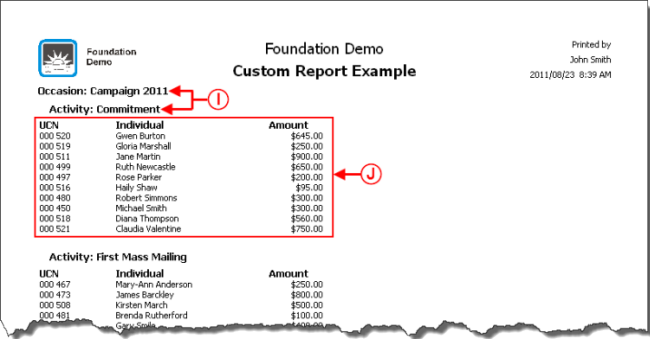
|
|
I: Example of report where the separations are offset.
|
J: Example of report where the option "Display grid" is not checked.
|
Adding Columns to the Report
|
To add a column to a report, click on the  button in the "Columns" tab that is at the bottom of the "Add custom report" window. button in the "Columns" tab that is at the bottom of the "Add custom report" window.
|
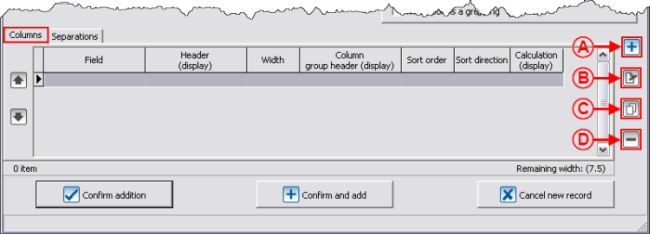
|
|
A: Allows you to add a new column to the report.
|
B: Allows you to modify an existing column.
|
|
C: Allows you to duplicate an existing column.
|
D: Allows you to delete a column from the report.
|
|
After clicking on the  button, this window opens. button, this window opens.
|
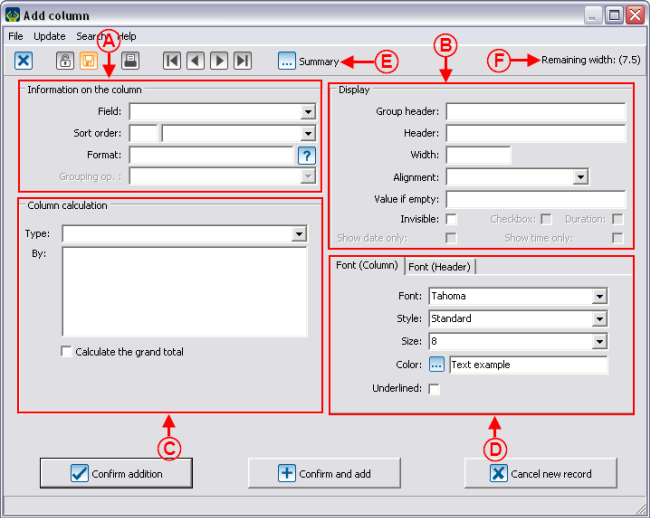
|
|
A: The section "Information on the column" allows you to specify the source of information to use and to configure information as well.
|
B: The section "Display" allows you to modify the presentation of the column in the report.
|
|
C: The section "Column calculation" allows you to do a mathematical operation in order to enter the result at the bottom of a column (e.g. the donations average by person, the total of the donations for an activity, the total of the donations for an occasion, etc.).
|
D: The "Font (Column)" tab allows you to choose the font to be used for the data lines.
The "Font (Header)" allows you to choose the font to be used in the header line of the column.
|
|
E: The " Summary" button is a shortcut to the "Summary management", if you want to quickly create a summary that will be available at the very bottom of the list of fields in A. Summary" button is a shortcut to the "Summary management", if you want to quickly create a summary that will be available at the very bottom of the list of fields in A.
|
F: The "Remaining width" displays the available space on the report.
NOTE: If the unit of measurement had been defined in centimetres in the visual options configuration, the "Remaining width" would be written in centimetres.
|
Information on the Column
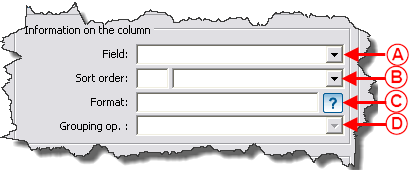
|
|
A: Allows you to choose the fields that will be present in the report.
It is also possible to choose, using the drop-down list, a summary. The list of summaries can be found at th very bottom of the drop-down list.
The following options are also available: "Configurable value", "conditional value" and "Calculation function", and are the three first choices of the drop-down list.
|
|
B: Allows you to decide on the order in which the information is displayed. In the first box, you have to specify the sorting priority and in the second box, you have to specify it is an ascending or descending order
Example: The sorting must first be in alphabetical order of client (1-ascending) and then in ascending order of UCN (2-ascending), so that:
If two clients have the same name and that one or the other has two transactionsto his or her name, both transactions from the same client will automatically follow each other:
UCN Client Amount
- 004 321 Smith, Matthew $300
- 004 542 Smith, Matthew $200
- 004542 Smith, Matthew $150
If the order by UCN has not been determined, the clients could have been mixed up:
UCN Client Amount
- 004 542 Smith, Matthew $200
- 004 321 Smith, Matthew $300
- 004 542 Smith, Matthew $150
|
|
C: Allows you to modify the presentation of a piece of data in the column.
The  button contains the indications on the configuration of format. button contains the indications on the configuration of format.
Example: The default format of the UCN is "000 000" and the UCN is "001 234". If the format were changed to "#", the UCN would become "1234".
Another example: The date format is "yyyy/mm/dd" and the date entered is "2011/07/28". If the format were changed to "mmmm", the date would become "July".
|
|
D: Allows you to choose a mathematical operation whereof the result has to be displayed in the columns of the data lines. This menu is active only if the option "This report is a grouping" is checked in the report main screen.
For more information on the grouping option and on the types of operations available, click here.
|
Display
|
For all the following examples concerning display, refer to the "Examples" section.
|
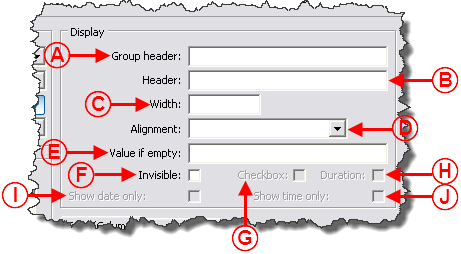
|
|
A: Allows you to indicate a reference to be displayed above the column header in order to identify groups of columns. To view an example of group header, see letter A.
|
|
B: Allows you to change the name of the column header on the report. By default, the name of the header is the same one as the field's. To view an example of header name different from the field's, see letter B.
|
|
C: Allows you to specify the space the column must occupy on the report. The unit of measurement depends on the one that was chosen in the visual options configuration. To view an example of column width, see letter C.
|
|
D: Allows you to choose the alignment of the data lines in the column. To view an example of alignment, see letter D.
|
|
E: Allows you to enter something in an empty field instead of leaving an empty field. To view an example of empty field, see letter E.
|
|
F: Allows you to configure a field without displaying it in the report.
For instance, to display the "Individual" column (that contains the individual's first name and last name) in alphabetical order of last names, you have to add the "Name" column, and assign it the sorting order. Since the "Individual" column already appears on the report, it is not necessary to see the "Name" column, so by checking "Invisible", the individuals will be sorted by last names and their family names will be visible only once.
To view an example of invisible field, see letter F.
|
|
G: Displays a check box on the report rather than 0 and 1 for the fields that are check boxes. To view an example of check box, see letter G.
|
|
H: Allows you to convert a numeric field in duration.
For example: "1,5" would become "1h30".
|
|
I: Allows you to remove the "Time" part of a "Date and Time" type of field.
For example: "2015/01/12, 8:53:24" would become "2015/01/12".
|
|
J: Allows you to remove the "Date" part of a "Date and Time" type of field.
For example: "2015/01/12, 8:53:24" would become "8:53:24".
|
Examples of Display
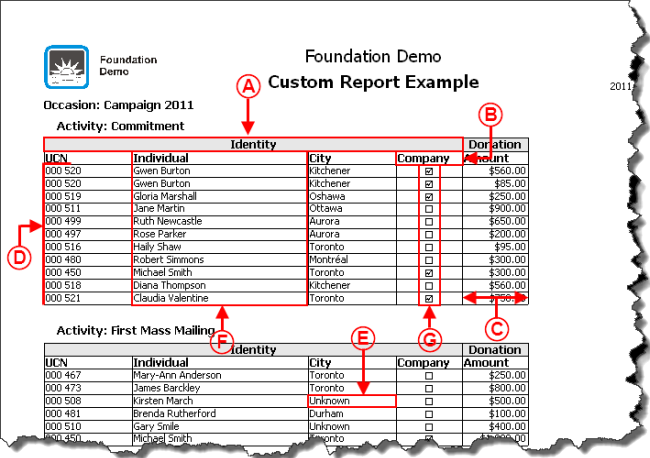
|
|
A: Group headers named "Identity" and "Donation" were added. So that these four fields are in the same group, you simply have to enter the exact same thing as in the "Group header" field when configuring the display.
|
B: The name of the field in the database was "Co./Org." and the name of the column header has been changed to "Company". To do so, you simply have to modify the "Header" field. By default, the name entered is the field name.
|
|
C: The column width is 1 inch.
|
D: The default alignment of the "UCN" was on the right, and it has been changed to be on the left. To do so, you simply have to select, using the drop-down list, the desired alignment.
|
|
E: This individual's file did not contain her city, so instead of remaining empty, it is marked as "Unknown".
|
F: The individuals are in alphabetical order of name, since the "Name" field has been added, but it is invisible. If the field had not been added, the "Individual" column would have been placed in alphabetical order of first name.
|
|
G: The box is checked if the donor is a company. If the "Checkbox" option had not been checked in the display configuration, it would be written "1" for check box and "0" for an empty box.
|
|
Calculation on Column
|
For the following examples concerning the calculation on column, refer to the "Examples of Calculation on Column" section.
|
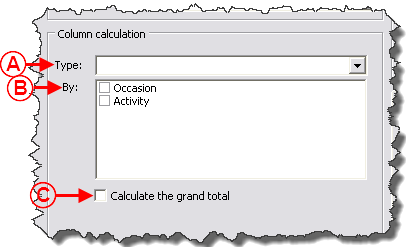
|
|
A: Allows you to choose a mathematical operation in order to enter a result at the bottom of the column (e.g. the average of donations per person, the total of donations for an activity, the total of donations for an occasion, etc.)
To view an example of calculation on column, see letter A.
There already six types of operations available:
Average: Calculates the average of the existing values (does not consider empty lines).
For example, if the values are: "2", "Empty", "Empty" and "4", the result will be "3".
Number: Counts the number of lines (does not consider empty lines, nor the "0's").
For example, if the values are: "1", "0", "Empty" and "2", the result will be "2".
Maximum: Indicates the greatest existing value.
Minimum: Indicates the smallest existing value (considers empty lines).
For example, if there is an empty line, the result will be "0".
Amount: Adds the values.
Number of cells: Counts the number of lines (considers empty lines). It is the only type of total available on the "Text" type of fields.
CAUTION: Do not confuse these operations with the grouping options.
|
|
B: Displays the list of the separations present in the report and indicates in which separation the calculation has to be done. For more information concerning separations, click here.
|
|
C: Displays or not a result at the end of the report. To view an example of grand total, see letter B.
|
Example of Calculation on Column
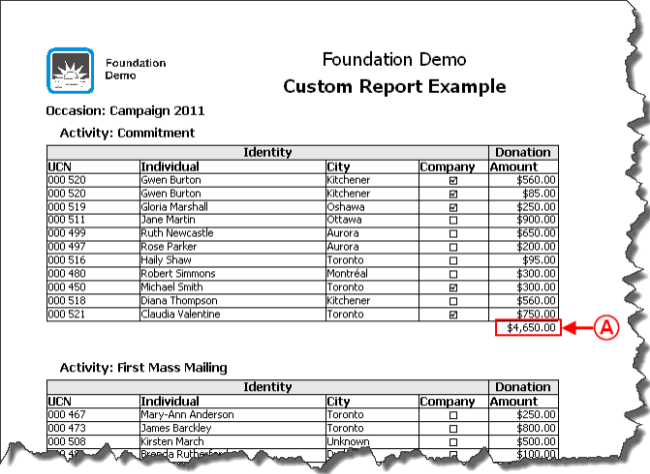
|
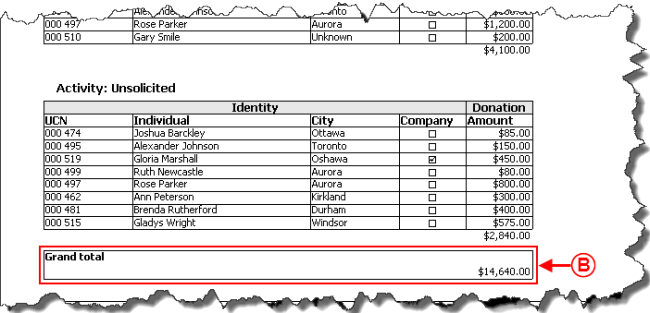
|
|
A: This calculation by column is the amount of the donations for the activity "Commitment" of the occasion "Campaign 2011".
|
B: The grand total is equal to the amount of all the donations for the occasion "Campaign 2011".
|
Adding Separations to the Report
Adding separations allows you to section the report based on a specific piece of information. The sectioning is done each time the report meets a new piece of information.
|
To add a separation to a report, click on the  button in the "Separations" tab that is at the bottom of the "Add custom report" window. button in the "Separations" tab that is at the bottom of the "Add custom report" window.
|
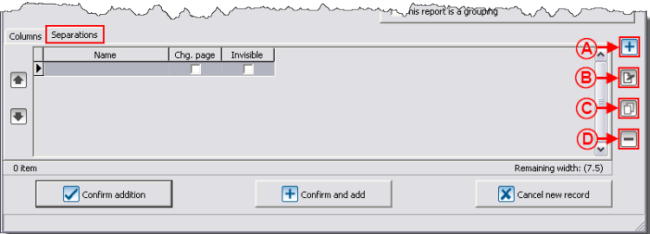
|
|
A: Allows you to add a new separation to the report.
|
B: Allows you to modify an existing separation.
|
|
C: Allows you to duplicate an existing separation.
|
D: Allows you to delete a separation from the report.
|
|
After clicking on the  button, this window opens. For all the following examples concerning the separations, refer to section "Examples of Separations". button, this window opens. For all the following examples concerning the separations, refer to section "Examples of Separations".
|
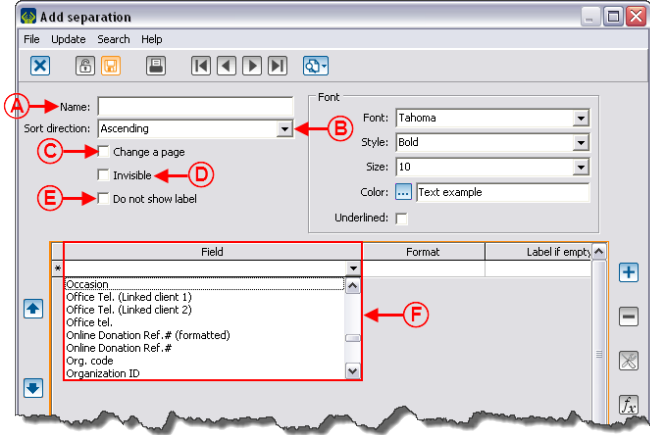
|
|
A: Allows you to choose a label for the separation. To view an example of named separation, see letter A.
|
B: Allows you to decide whether the separations will be sorted in ascending or descending order. To view an example of ascending sorting order, see letter B.
|
|
C: Allows you to change page between each separation. To view an example of page change between separations, see letter C.
|
D: Allows you to insert a separation without displaying it in the report. To view an example of invisible separation, see letter D.
|
|
E: Allows you not to display the name given in A. To view an example of separation without label, see letter E.
|
F: Allows you to specify on which field the separation has to be based. To add more than one, click on the  button on the right. To view an example of separation containing two fields, see letter F. button on the right. To view an example of separation containing two fields, see letter F.
|
|
NOTE: Separations can cause errors if they are misinterpreted. For instance, the "Client" field contains the piece of information "Company name" OR "Last name" AND "First name". So, if two clients have exactly the same last name and first name, they will be grouped because the information of the "Client" field is the same. Therefore, it is wise to separate the clients by "UCN" because it is impossible that two clients have the same "UCN".
|
Examples of Separations
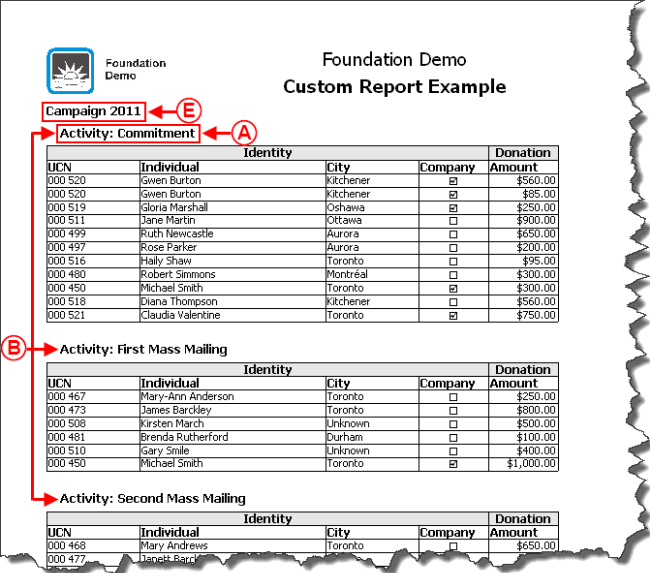
|
|
A: The separation label is "Activity".
|
|
B: The "Activity" separations are sorted in asecnding order.
|
|
E: The separation is named "Occasion", but the label is not visible.
|
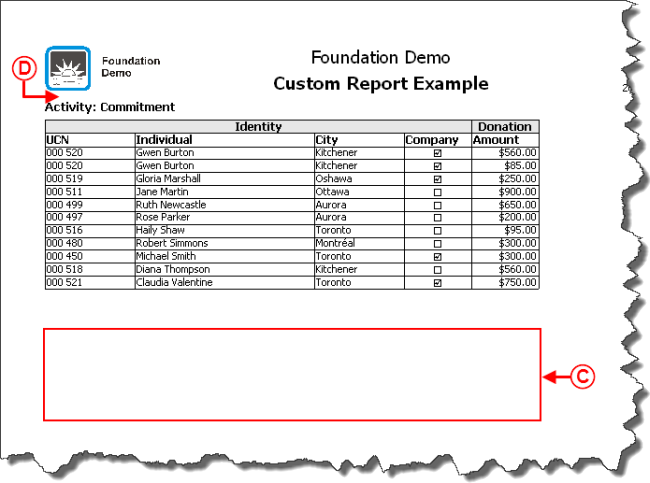
|
|
C: The option "Change a page" has been checked, there is therefore only one activity per page. The second activity can then be found on the second page.
|
|
D: A separation per activity has been added and the "Invisible" box has been checked. This way, the name of the separation does not appear.
|
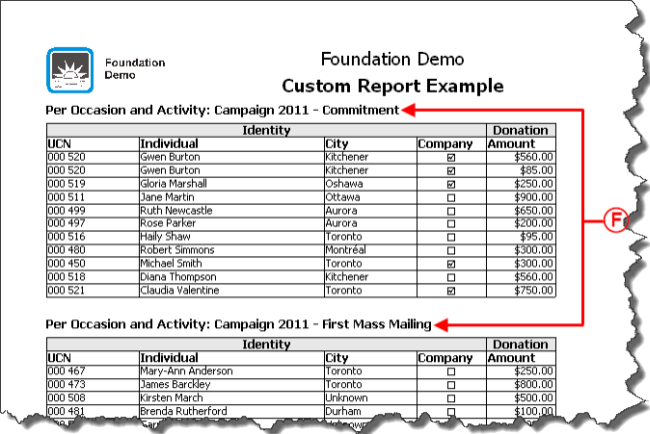
|
|
F: Instead of adding two separations(one "Occasion" separation and one "Activity" separation), only one separation with two fields has been added (the separation label is "Per Occasion and Activity"), which allows the name of the occasion and the name of the activity to be on the same line and in each separation. If two separations had been added, the name of the occasion would have been indicated only once; which means right before the first activity, to view an example, see letters A and E.
|
Configurable Value
Example of Configurable Value
Conditional Value
Example of Report with a Conditional Value
Calculation Function
Example of the "Calculation Function" Field
Using the Option "This report is a grouping"
Example of an Onscreen Search
Result of the Onscreen Search
Document name: ProDon:Custom Reports
 is active (blue).
is active (blue). 
![]() button.
button.
![]() button.
button.


















